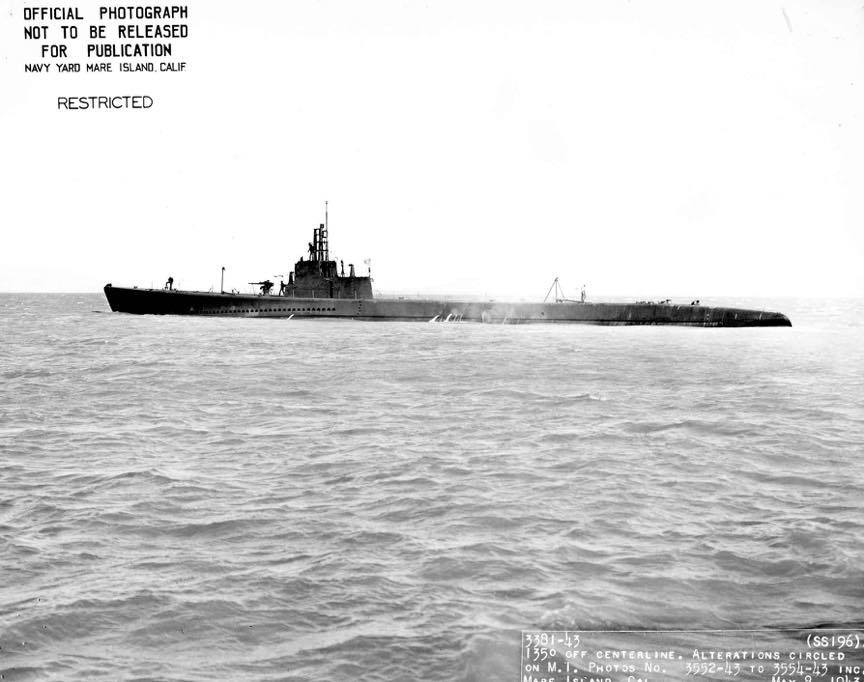Searaven SS-196
 Searaven
Searaven
(SS-196: dp. 1,450 (surf.), 2,350 (subm.); 1. 310'6";
b. 27'5"; dr. 13'8"; s. 20 k. (surf.), 8.75 k. (subm.)
cpl. 55; a. 1 3", 8 21" tt.; cl. Sargo)
Searaven (SS-196) was laid down on 9 August 1938 by the Portsmouth (N.H.) Navy Yard; launched on 21 June 1939, sponsored by Mrs. Cyrus W. Cole; and commissioned on 2 October 1939, Lt. Thomas G. Reamy in command.
In the two years preceding America's entry into World War II, Searaven operated in Philippine waters conducting training and maneuvers. At the outbreak of war between the United States and the Japanese Empire, the submarine was at the Cavite Navy Yard in Manila Bay. During her first two war patrols in December of 1941 and the spring of 1942, she ran supplies to the American and Filippino troops besieged on the Bataan Peninsula and Corregidor Island. In a night action in the Molucca Strait on 3 February 1942, she torpedoed a Japanese destroyer and claimed her first victim of the war.
Searaven conducted her third war patrol in the vicinity of Timor Island of the Netherlands East Indies, from 2 to 25 April 1942. On the 18th, she rescued 32 Royal Australian Air Force men from enemy-held Timor. Five days later, fire broke out in her main power cubicle, immobilizing Searaven completely. Snapper (SS-185) assisted her into port in Australia.
Searaven's fourth war patrol was a quiet one and returning from her fifth patrol she claimed 23,400 tons sunk and 6,853 damaged. This tally, however, went unconfirmed. She ended her fifth patrol on 24 November 1942 at Fremantle, Australia, where she underwent refit. On 18 December, she got underway from Fremantle, bound for the Banda Sea, Ceram Sea, and the Palau Islands. In the Banda Sea, she welcomed the New Year by loosing a spread of three torpedoes at the minelayer, Itsuku Shima. Again the sinking claimed by Searaven went unconfirmed. Two weeks later, on 14 January 1943, the submarine pumped four torpedoes into the freighter Siraha Maru and collected her first confirmed victory. On 10 February 1943, she sailed into Pearl Harbor, Hawaii, and, two days later, she set out for overhaul at Mare Island, Calif.
She completed overhaul on 7 May and returned to Pearl Harbor on the 25th. On 7 June, Searaven departed from Pearl Harbor for her seventh patrol this time in the Mariana Islands area. During this patrol, she reconnoitered Marcus Island, but encountered no enemy shipping. She put into Midway Island on 29 July 1943 for refit. Her eighth war patrol began at Midway on 23 August. She plied the waters off the northeastern coast of Honshu, Japan, but found no enemy ship worth a torpedo. After a month and one-half at sea, the submarine made Pearl Harbor on 6 October. A month later, she stood out for her ninth patrol. She patrolled the Eastern Carolinas and, for a three-day period, operated with a wolfpack of submarines which was used as part of the defensive screen for the Gilbert Islands operation. On 25 November 1943, she got her second confirmed kill, sending the 10,052-ton tanker Toa Maru, to the bottom with four torpedoes. She sailed back into Pearl Harbor on 6 December.
Her tenth war patrol, 17 January to 3 March 1944, was occupied by photo reconnaissance of Eniwetok Atoll and lifeguard duty for the air strikes on the Marshalls Marianas, and Truk. She rescued three airmen, but put into Midway on 3 March with no additional sinkings to her credit. On 26 March, she embarked upon her 11th war patrol. Her assigned area was the southern islands of the Nanpo Shoto, the Bonins. She made two attacks during this patrol, claimed two more sinkings, but was officially credited with none.
After a complete overhaul at Pearl Harbor Searaven set course for the Kuril Islands area. Tweive enemy vessels were sunk during this patrol. On 21 September 1944, in a night surface attack, the submarine torpedoed and sank an unescorted Japanese freighter Rizan Maru, that had dropped behind her convoy. On the night of 25 September, Searaven engaged two trawlers, four large sampans, and four 50-ton sampans. Searaven passed down the column of eight sampans and two trawlers, 250 yards abeam, engaging from one to three at a time at practically point blank range. Those that did not sink on the first pass were given another dose of the same treatment until all were destroyed.
On 1 November, Searaven sailed as part of a coordinated attack group which also included Pampanito (SS-383), Seacat (SS-309), and Pipefish (SS-388)— for her final war patrol. Operating in the South China Sea, east of Hainan Island, the submarine closed out her combat career by sinking one transport of the Hainan Maru class and an oiler of the Omurosan Maru type. With combat ended, Searaven was assigned target and training duties for the remainder of the war.
Searaven was one of the target ships in the 1946 atomic bomb test, Operation "Crossroads," at Bikini Atoll. She escaped the tests with only negligible damage. The submarine was decommissioned on 11 December 1946, sunk as a target on 11 September 1948, and struck from the Navy list on 21 October 1948.
Searaven earned ten battle stars for World War II service.
